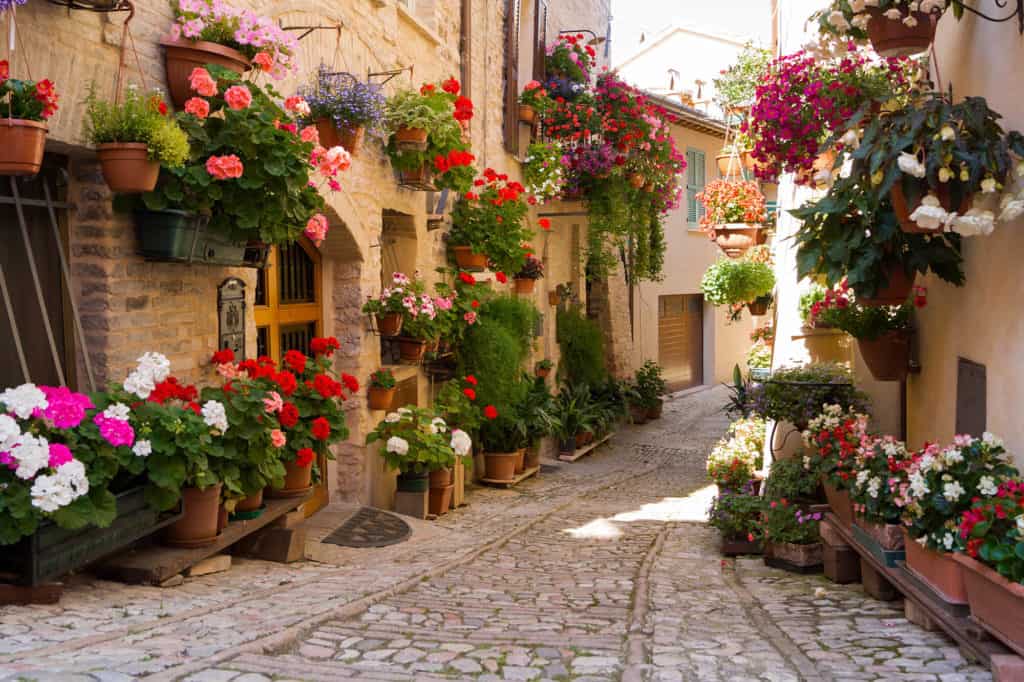Millennia of culture and art
Legendary festivals, a world-renowned university, charming hilltop villages, immaculate ancient strongholds, unsurpassed bucolic beauty. This is Umbria. Most visit the region for its natural wonders – the gently rolling emerald hills in springtime, summer fields ladened with sunflowers, autumn’s bountiful olive and grape harvest and the Apennines shrouded in winter snow. It’s no wonder many say Umbria rivals next door neighbour Tuscany. Add to the equation medieval masterpieces, Renaissance gems, and an extensive offering of contemporary art, some might even say go so far as to say it surpasses la bella Toscana. The region remains hidden under the radar, one of Italy’s best kept secrets. And now we’re giving you all the artsy intel. But remember, shhhh, please don’t tell!
Art History’s Masterpieces
Umbria’s colossal foothold in art history begins even before young Giotto studied under Cimabue and had the world marvelling at his famous series of frescoes for the Upper Church of the Basilica di San Francesco in Assisi. Umbria’s National Archaeological Museum located in Perugia offers the most prominent archaeological collection in Central Italy and boasts an extensive compilation of Etruscan funerary art. Though today it is often the region less travelled, it was once a pivotal pit stop along Via Flaminia, a main artery connecting Rimini to Rome in the 2nd century BC. As a result, the region possesses many a Roman ruin, including walls, temples, baths and amphitheatres. It was also once HQ for the Great Duchy of Spoleto, a territory overseen by Lombard Duke Faroald in 570 AD.

And then, Giotto entered stage right and the rest is art history. Guided by maestro (master) Cimabue, Giotto was a predecessor to many early Renaissance artists who found a flourishing home in Umbria for their art including Fra Filippo Lippi, whose works in Spoleto’s Duomo are a must-see, along with Pinturicchio and his Baglioni Chapel in Spello and the frescoes by Luca Signorelli in San Brizio Chapel located in Orvieto’s Gothic Duomo, works which anticipated Michelangelo’s famoso (famous) Sistine.

Frescoes by Pinturicchio in the Baglioni Chapel, Spello 
Charming view of a typical alley of Spello
Head to Umbria’s Upper Tiber, the valley where Umbria and Tuscany meet and you’ll find the path of Piero della Francesca. An artistic great, though perhaps lesser-known amongst his Renaissance comrades, della Francesca’s mathematical exactitude emphasized his rational approach to painting, incorporating dynamic geometric compositions with grounded perspective and realistic representation. He was heavily influenced by his more notable contemporaries including Masaccio, Donatello and Brunelleschi.
What about Perugino you say? Umbria’s famous artist and Perugia’s golden boy (not for nothing his name was Perugino) was likened to Leonardo (da Vinci of course) by Raffaello’s father, Giovanni Santi. The Umbrian school Renaissance painter was an apprentice to della Francesca and was heavily influenced by Botticelli. A mentor to Raffaello, he is often best known for his work in the Sistine Chapel along with the Raphael Rooms. The work of Umbria’s hometown hero though be found in the Galleria Nazionale dell’Umbria and his native, Città della Pieve, as well as in Umbrian towns like Montefalco, Spello, Panicale, Foligno and Assisi.
Let’s get contemporary
Umbria is undoubtedly chock-a-block with Renaissance wonders but the region is also artistic testimony to some of Italy’s most avant-garde contemporary artists. Take Gino de Dominicis and his Calamita cosmica (cosmic magnet). Located in Foligno’s Italian Centre of Contemporary Art inside the ancient Holy Trinity Church, the meaning behind this larger-than-life contemporary piece is still a mystery, as was much of de Dominicis’ life. The enormous skeleton is holding a magnetic golden rod which marks time.
Umbria’s Città di Castello is home to one of Italy’s most important 20th century abstract painters, Alberto Burri. A member of the radical Arte Povera movementwhich gained notoriety in Italy in the ‘60s and ‘70s, he is famous for his experimental works of art such as crackled canvases, warped metal, burnt pvc, his burlap bag i sacchi (sack) series which he worked in every which way through stitching, patchwork and paint, and Il Cretto, the largest land art site specific work of art. Located in his home town, Fondazione Burri showcases 200 works of art located in two complexes.
Tucked away in the hilltop town of San Linardo in the province of Perugia is Giardini dei Lauri, a personal contemporary art collection of around 300 works chosen by Neapolitan art collectors Angela and Massimo Lauro. The expansive gallery, which also serves as a non-profit for burgeoning artists and their artwork, as well as a performance and special events space, is an open door to those seeking freedom to experiment and push the boundaries of contemporary art. We recommend taking an hour or two to indulge in the exceptional pieces from young artists from Italy, US, UK and other parts of Europe.
The Magic of the Metaphysical
Scarzuola is Umbria’s magical city, a città metafisica (metaphysical city) created by contemporary artist, Tomaso Buzzi. Located in the village of Montegabbione, Scarzuola was designed to be the ideal city though it began as a Franciscan monastery. Buzzi, an architect from Milan, envisioned this sacred city to be an otherworldly unveiling of life’s most pressing obscurities. A surrealist philosophical interpretation of the artist’s beliefs and the mysteries he hoped to uncover through allegorical architecture, which draws from the classical, medieval and Renaissance periods – all led by a main overarching theme of Neo Mannerist elements. Quotes and symbols were also thrown in for some added spice. Buzzi unfortunately never had a chance to see his fantastical creation to the end, but thanks to his nephew, Marco Solari, his vision was completed. Visits can be arranged by booking a paid private guided tour in advance.
